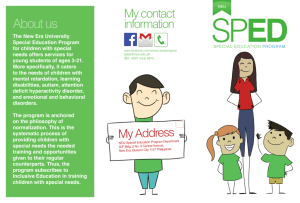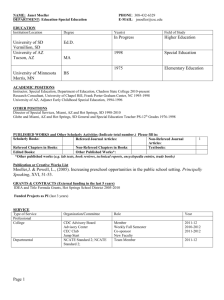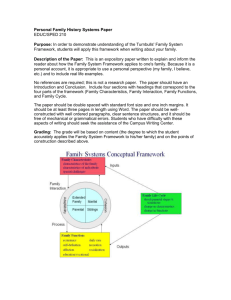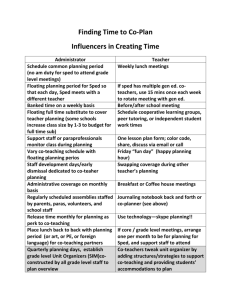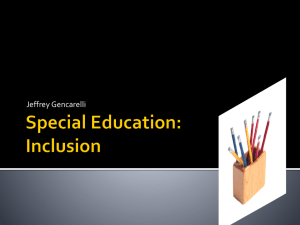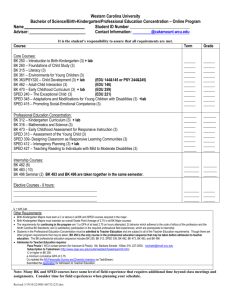California State University, Chico
advertisement
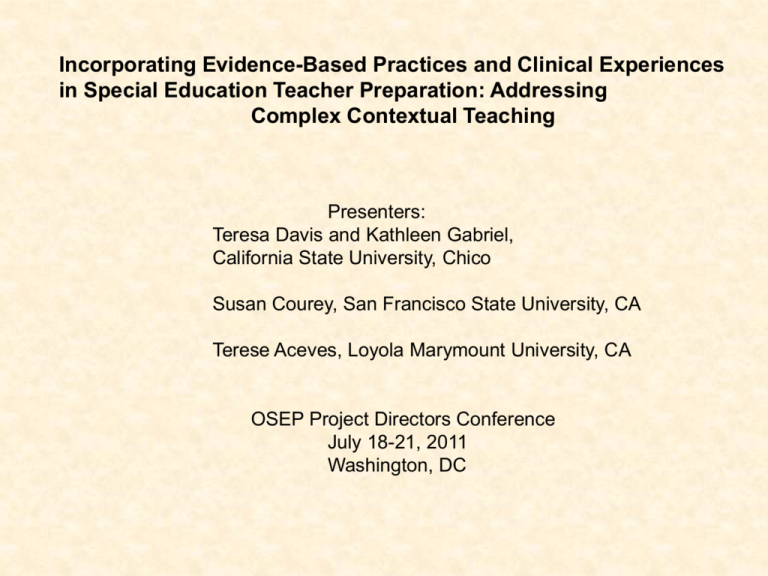
Incorporating Evidence-Based Practices and Clinical Experiences in Special Education Teacher Preparation: Addressing Complex Contextual Teaching Presenters: Teresa Davis and Kathleen Gabriel, California State University, Chico Susan Courey, San Francisco State University, CA Terese Aceves, Loyola Marymount University, CA OSEP Project Directors Conference July 18-21, 2011 Washington, DC Project Next Steps: Strengthening Preparation for Secondary Special Educators in Rural Schools Teresa Davis, Ph.D., Project Director 325T Kathleen Gabriel, Ed.D., Site and Curriculum Coordinator School of Education Special Education Program California State University, Chico Tmdavis@csuchico.edu; kfgabriel@csuchico.edu NCATE ACCREDITED: Preparing Candidates to be “Effective-Reflective-Engaged” California State University, Chico Created by an 1887 legislative act as the Northern Branch State Normal School of California California State University, Chico is the second-oldest campus in the CSU system - one of 23 campuses, and is located in Chico, California, about 90 miles north of Sacramento Student population is 16,000 from 33 states and 57 nations Combination of residential students and distance learners has led to on-campus supports along with efforts to make these supports available to remote students CSU, Chico Special Education Service The Special Education Area Program serves the mostly mountainous, 38,000 square mile area above red line; because of this, CSU, Chico entered into distance education early on, with satellite delivery of courses Now distance education is delivered in both synchronous and asynchronous video streamed format for remote learners CSU Chico Special Education Program Strengths 1995-2008 (before 325T Project) • • • • • • • Multiple pathways to high-incidence K-12 certification with 60-75 candidates per year in combination of pathways with Bilingual certification option (for those qualified) Merged Preparation Program: Multiple Subject/Education Specialist for 15 years; strong curriculum focus on K-6 English learner emphasis and preparation in Guided Language Acquisition and option in Bilingual Authorization (Spanish) Integrated, continuous field and coursework Access to courses, utilizing technology for distant learning Service-Learning experience and use of pedagogy in student teaching Candidate retention services and outcomes (95% graduation rate since 1995) Project NEXT STEPS Objectives 2008-2013 325T Grant Objective 1. Prepare training sites and candidates to meet the needs of diverse youth with high incidence disabilities, including English Learners, using Evidence-Based Practices. (Domain B & C) Objective 2. Provide intensive training in core subject matter and Evidence-Based Practices. (Domain C) Objective 3. Restructure and enhance a model integrated training program in order to prepare Highly Qualified secondary special educators. (Domain B) Objective 4. Fashion a support network to ensure candidate retention and success in the preparation program and in the profession; Objective 5. Reduce shortage of HQTs for youth with high incidence disabilities. Objective 1: Prepare Secondary Sites Using Evidence-Based Practices The basis for our transformative design is the Report of the Blue Ribbon Panel on Clinical Preparation and Partnerships for Improved Student Learning, Transforming teacher education through clinical practice: A national practice to prepare effective teachers. Commissioned by NCATE, 2010. Project Activities in 2010-2011 1. Dr. Donald Deshler, Project Expert Consultant: Site visit and professional development for faculty and field partners (including individual meetings with faculty to review syllabi) Focus on EBP’s in literacy development provided impetus for site development; KU Center for Research on Learning 2. Site partners review of syllabi with faculty in after school sessions 3. Routine partnership meetings and annual feedback surveys 4. Building Exemplary Secondary Sites, summer 2011 5. Summer Strategic Instruction Model (SIM) Training for cooperating teachers, paraprofessionals, principals representing the three partner sites (August 2011) 6. Implementation of SIM in targeted classrooms Objective 2: Provide intensive training in Evidence-Based Practices The basis for our transformative design is the (1) Report of the Blue Ribbon Panel on Clinical Preparation and Partnerships for Improved Student Learning, Transforming teacher education through clinical practice: A national practice to prepare effective teachers. Commissioned by NCATE, 2010; (2) KU Center for Research on Learning – Strategic Instruction Model (SIM); (3) Pianta, R., Hitz, R., and West, B (2010). Increasing the application of developmental sciences knowledge in educator preparation: Policies and Practice Issues. NCATE. Emerging Project Activities in 2011-2012 1.Implementation of SIM in targeted general and special education classrooms in three secondary sites. 2.Align coursework assignments to site-based implementation of E-B practices. 3.Expand focus on pupil data to monitor use, efficacy of EBP’s. 4.Track school-wide data and measures including attendance and office referrals. 5.Provide opportunity for the trained cohort of cooperating teachers to attend the California S.I.M. conference in San Francisco in October. This “leadership team” to expand opportunities for additional cooperating teachers. 6.Build base of support for tiered intervention leadership teams through PLC’s in secondary schools. Objective 3: Restructure and enhance a model integrated program to prepare HQ secondary special educators. Research about adolescent development to guide our process and emerging program elements: Pianta, R., Hitz, R., and West, B (2010). Increasing the application of developmental sciences knowledge in educator preparation: Policies and Practice Issues. NCATE. New knowledge of adolescent development is especially important since the adolescent years are one of the most important periods of human cognitive, biological, and social growth and change. Adolescents have four basic developmental needs to connect to teacher preparation content: Adolescent Needs: Program Elements: 1.Relationships: I want to connect with others. Peer Interactions; Coop. Learning 2.Autonomy: I want to be independent. Differentiated Learning 3.Competence: I want to experience success Basic literacy/math skills; SIM; in what I do and feel like a worthwhile person. Critical Thinking Skills 4. Relevance: I am more motivated and challenged Application to real-life; Service-Learning; by skills and content that relate to my life experience. Experiential learning Strategic Instruction Model http://www.kucrl.org/sim Learning Strategies – a person’s approach to learning and using information Sentence Writing Strategy - instruction provided for secondary preservice candidates and cooperating teachers Content Enhancement Routines - used by teachers to teach curriculum content to academically diverse classes in ways that all students can understand and remember key information. Framing Routine - instruction provided for secondary preservice candidates and cooperating teachers Scheduling a Merged Secondary and Special Education Program Meeting the Unique Needs of the Secondary Schools Integrating Field and Coursework Components Demands of general and special education content Subject specific content and differentiation Learning Strategies Licensure and Competencies Supervision and Teaching Schedules for faculty Integrated Single Subject with Education Specialist Mild/Moderate - Pilot Curriculum Sequence 2010-2011 SEMESTER 1 – Graduate Year PRE-REQUISITES & UNDERGRADUATE SEMESTER 2Graduate Year SPED 569-Field Experience in Special Education 3 EDTE 672-Reading/Language Arts: ELL/Academic Access 4 SPED 691 CollaborationConsultation; SPED Laws & Regs SPED 343-Overview of Special Education 3 *EDTE 533 Subject Specific Pedagogy 3 SPED 680-Autism (part II) SPED 580-Introduction to Autism 2 SPED-692- Behavior Management (Exceptional Needs) 3 SPED 672 Curriculum and Instruction M/M SPED 564-Managing Learning Environments 2 SPED 560 Math Pedagogy K12 3 SPED 664 Academic Literacy & Comm Skills SPED 561 Curriculum and Instruction 3 SPED 501 Monthly Seminar 1 SPED 560 Assess & Evaluation SINGLE SUBJECT CSET EXAM & CBEST *Student Teaching: General Education Single Subject 9 *Student Teaching: Special Education ACADEMIC UNDERGRADUATE MAJOR PACT EVENT RICA (Reading Instruction Competence Assessment) Exam SPED 501 Monthly Seminar Fall 2011 Dual Credential Schedule (Draft) Single Subject/ Education Specialist Mild/Moderate 8:00 am Monday Tuesday Wednesday SiteSt.Tchg to 3:45 Site to 11:30 AM Site to 3:30 Site to 4 PM PM 9:00 “ 10:00 “ 11:00 “ 12:003:00 pm 4:00 pm Thursday EDTE 673 SPED 560-4:30 Friday Site to 12 PM SOED 69212:30 SPED 501 5:00 pm EDTE 533 (5:30) 6:008:20 pm EDTE 533 EDTE 672

